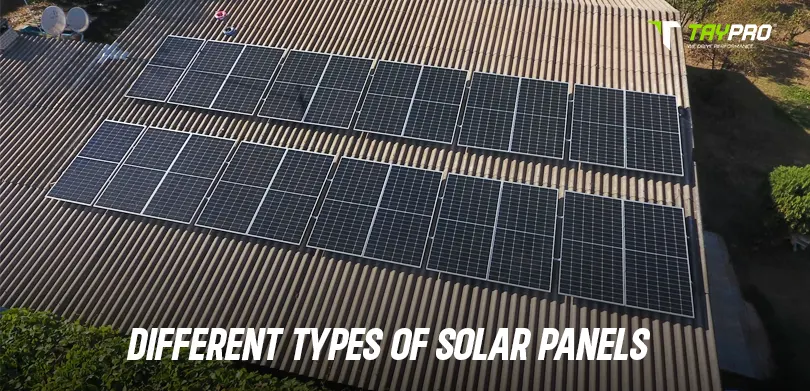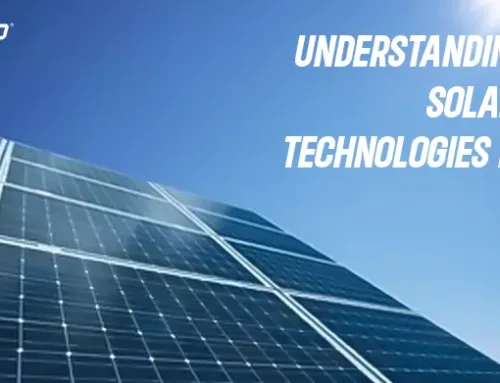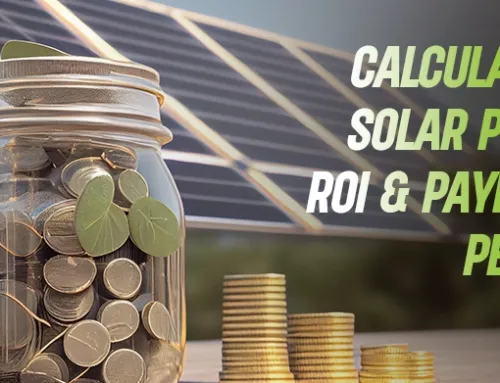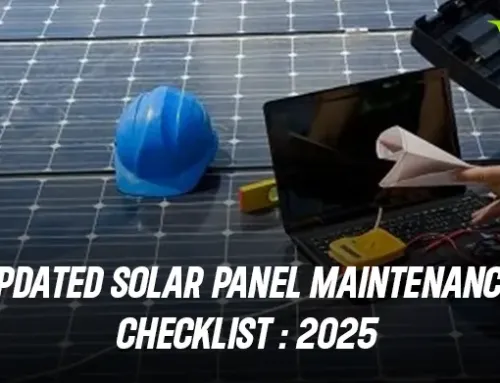Solar energy has played a pivotal role in meeting the power requirement in both residential and commercial fields. India positioned itself at 5th rank worldwide in solar cell deployment across the country, irrespective of urban and rural areas. India is leading rigorously to stand as the global leader in producing solar energy in the coming years.
There are three main types of solar panels – monocrystalline, polycrystalline, and thin-film. Some solar panels are budget-friendly whereas some are highly-efficient. The choice of a specific type of solar panel depends on the quality, operational efficiency, budget extent, and preferences.
What Is Solar Panel And What Are The Types Of Solar Panels?
A solar panel is a device that absorbs sunlight and transforms it into usable electricity. Also known as the photovoltaic cells, these are made up of silicons. Once the sunlight falls on the PV cells and gets absorbed, a direct current (DC) is generated through the panel’s wiring. This direct current is later on converted into alternating current (AC) through inverters. This alternate current is actually a usable power utilised for the household and business needs.
There are different types of solar panels, which are used for specific purposes and requirements. Out of a varied options, the three main types of solar panels are monocrystalline solar panels, polycrystalline solar panels, and thin-film solar sheets. These types of solar panels vary in terms of costing, operational efficiency, output, lifespan, and maintenance.
Each of these solar panels have different installation cost, capabilities, space requirement, and appearance. The best quality solar panels come with higher efficiency levels and prolonged lifespan. It is also vital to maintain the efficiency of the solar cells by consistent solar panel cleaning. This removes the soiling from the PV cells and keeps them optimally functional.
Monocrystalline Solar Panels
Monocrystalline solar panels are commonly used and preferred type of solar panels. These are made from single crystals and are highly efficient among other types of solar panels. Using the Czochralski method, monocrystalline panels are created from a single pure silicon crystal and given a smooth, black appearance.
Among monocrystalline solar panels vs polycrystalline solar panels, monocrystalline solar panels stand out due to its efficiency and reliability, despite being the oldest type of solar cell.
Polycrystalline Solar Panels
On the other hand, polycrystalline solar panels are made from the fragments of silicon rather than the actual crystals. Blue in appearance, polycrystalline solar panels are moderately efficient as compared to the monocrystalline solar panels. These solar panels have lower heat-resistance and a more affordable price range.
Though polycrystalline solar panels have become more popular among residential or mid-scale solar installers for its lower cost, it is still not considered as the highly efficient solar panel.
Thin-film Solar Panel
Thin-film solar panels are an emerging and easy to produce solar module type. Produced using a variety of materials instead of sole silicon, this solar panel type is 350 times thinner than the other types of panels, as stated by the Tata Power. Thin-film solar panels can be folded and wrapped up easily around any structure as the need of the user.
Thin-film solar panels are easy to handle and highly flexible, making it suitable for varied needs or purposes. These are light-weighted and budget-friendly thereby, becoming the favourite for modern household users. Thin-film solar panels is a novel technology, completely distant from monocrystalline and polycrystalline solar panels.
Bifacial Solar Panel
Bifacial solar panels, as its name denotes, have PV cells on both sides and generate electricity through sunlight accordingly. In this case, solar energy is produced through both sides of solar panels via the reflected sunlight.
Bifacial solar panels are more profitable than other types of solar panels. They produce higher energy even in the arid and snowy regions. This solar panel type is ideal for high-utility scale solar plants and zones with high reflectivity.
Bifacial solar panels can generate 20% – 30% more solar power than the single-sided panels. These solar panels are highly durable with lower operational costs over the time.
Concentrated Photovoltaic Solar Panels
CPV or concentrated photovoltaic solar panels is an advanced medium of generating solar power through lenses or curved mirrors. In this solar panel type, the sunlight is primarily concentrated on the most efficient PV cells to maximise productivity. Occasionally, a tracking system is integrated with these panels to monitor the path of sunlight.
Concentrated photovoltaic solar panels are highly efficient and expensive. It is mostly useful during the time of high sunlight or summer season to optimise maximum solar power. This solar panel type is only ideal for highly invested commercial solar plants, as it requires consistent maintenance, tracking, and cooling mechanisms.
Monocrystalline vs Polycrystalline Solar Panels
Monocrystalline solar panels is created from a single crystal of silicon without any modifications. It is highly efficient with maximum energy output.
Polycrystalline solar panels is made from several crystals of silicon. As it is made from the fragments of silicon, it is less efficient than the monocrystalline solar panels.
Monocrystalline panels are uniformly black in shade while polycrystalline panels are bluish in appearance.
Monocrystalline solar panels are highly durable considering its optimum efficiency and advanced technology. Whereas, polycrystalline solar panels have comparatively less durability than the former one.
How To Choose The Right Solar Panel Type?
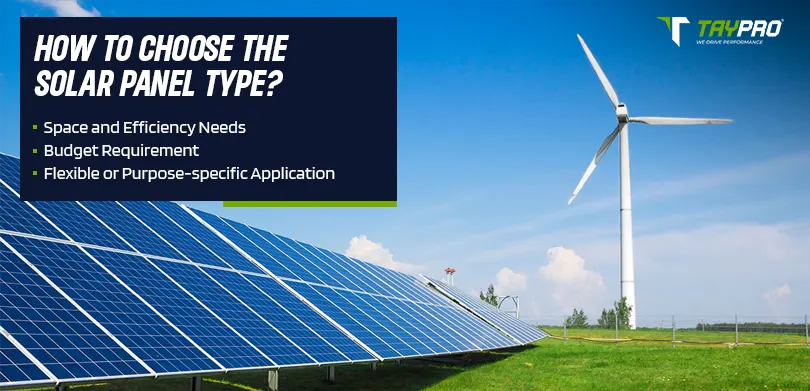
Solar panels are designed to convert maximum sunlight into usable energy. However, it is equally vital to consider and install the best-suited and right type of solar panel. Be it monocrystalline, polycrystalline, or thin-film, the installed solar panels should adhere to the budget, space, performance, and maintenance requirements.
Considering the space constraint, a monocrystalline solar panel is the right choice that provides maximum output within a small space. In the case of extensive space like a huge rooftop of a school, polycrystalline solar panels are feasible in terms of both performance and cost.
Thin-film solar panels can be used for special projects or assignments considering its reliability and flexibility. Monocrystalline solar panels are expensive but assure long-term savings. It is suitable for those with a huge budget and long-term plans for solar generation.
Budget Considerations
Polycrystalline solar panels generally have moderate costs due to its easy production. It provides ample output within a reliable budget. It may cost between ₹ 20 to ₹ 30 per watt in India.
Monocrystalline solar panels are expensive considering its complex generation process. However, it requires less space and gives maximum returns further. These panels may cost between ₹ 30 to ₹ 50, depending on the brand.
The thin-film solar panel is dynamic and produced using various materials. So, the cost of this panel depends on its composition and specified need.
Capability and Efficiency
Monocrystalline solar panels ensure high operational efficiency. They have high operational capacity and assure prolonged lifespan. The average efficiency level of monocrystalline solar panels ranges between 18% – 25%. They are efficient even in cloudy zones and have great tolerance to heat.
Polycrystalline solar panels are made from several crystals of silicons. Due to certain impurities, these panels are comparatively less efficient than the monocrystalline solar panels. They have an efficiency range of 12% – 18%. Polycrystalline solar panels give more output in hotter weather.
Thin-film solar panels have a huge tolerance to shading than the other two types of solar panels. It gives more output in the hotter conditions and even in low-light zones. The efficiency ranges between 7% – 12%.
Materials Used
Monocrystalline solar panels are produced using a single silicone crystal, which gives them a sleek, dark black look. It is generally framed within anodised aluminium with a tempered glass on top of the panel surface.
Polycrystalline solar panels are produced using numerous crystals of silicon. It usually has a white or silver frame and has tempered glass on the top.
Thin-film solar panels are produced from various materials like CIGS, CdTe, etc. It is a frameless option and can be placed dynamically anywhere one needs.
Appearance and Structure
Monocrystalline solar panels are black in appearance. They are placed in a pyramid form, ensuring even absorption of sunlight within a less space.
On the contrary, polycrystalline solar panels require a huge space for proper installation. They give a bluish and rectangular appearance due to its production from various crystals of silicon. Their production is more environment-friendly than the former one without wastage of silicons.
Considering the above factors, one can select the best quality solar panels for optimum power generation and high lifespan of the solar panel system.
FAQs
| What is a solar panel? A solar panel is a kind of electric device that absorbs sunlight and converts it into usable energy through inverters. A direct current is passed through the panel wires in the form of electric wave and it transforms into alternating current i.e. usable power. |
| What are the three main types of solar panel systems? The three main types of solar panels are monocrystalline, polycrystalline, and thin-film solar panels. Each differs by appearance, performance, cost, and longevity. |
| What is the monocrystalline solar panel made of? Monocrystalline solar panels are made up of a single, pure silicon crystal using the Czochralski method. |
| Are polycrystalline solar panels highly efficient? Polycrystalline solar panels are moderately efficient compared to the monocrystalline solar panels. They have a lower lifespan than the latter one. |
| What is the Czochralski method? The Czochralski method is the process of creating a single crystal through seed while melting the material. The material like silicone is melted in a crucible at a certain atmosphere. A rotating seed is pulled out from the melt and the crystal is formed after that material gets solidified around the withdrawn seed. |
| Why is the thin-film solar panel more popular among the modern solar users? The thin-film solar panels are inexpensive, easily portable, highly flexible, and suitable for household or small-scale purposes. It is made up of different materials rather than one silicon. |

